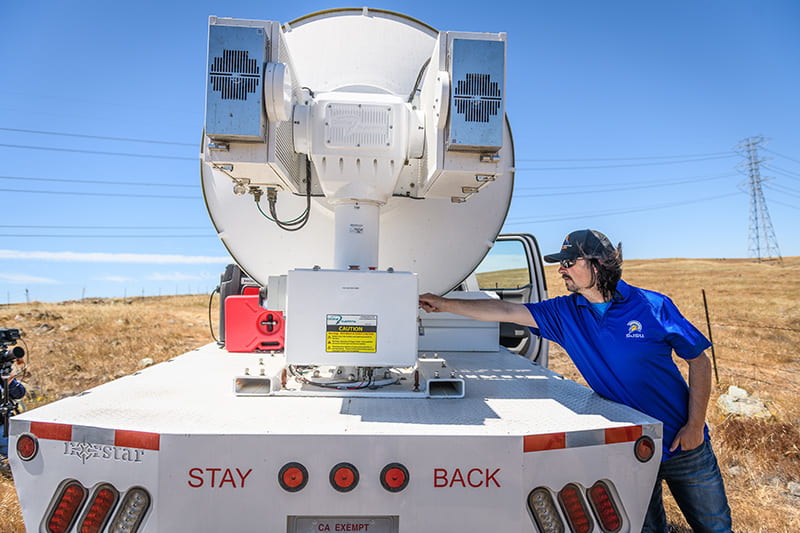
Craig Clements, director of the SJSU Wildfire Interdisciplinary Research Center, with a truck equipped for wildfire surveillance. Photo by Robert C. Bain
Wildfire research at San José State University is about to move faster than ever before — and in partnership with key industry and government stakeholders — thanks to a grant from the National Science Foundation (NSF).
The NSF grant awards the SJSU Wildfire Interdisciplinary Research Center (WIRC) the designation of an Industry-University Cooperative Research Center (IUCRC), making it part of a program designed to accelerate the impact of research by establishing close relationships with industry innovators, government leaders and world-class academic teams.
WIRC will be the only IUCRC in the U.S. focusing on wildfire research.
Functioning as an IUCRC will allow wildfire research at SJSU to move at an unprecedented speed, explained Craig Clements, director of WIRC and professor of meteorology. Typically, the academic research process can require months of waiting for funding and approval. In this case, funding is available and projects can start as soon as the stakeholders approve.
WIRC will partner with a board of industry innovators and government agencies, including: San Diego Gas & Electric Company; Pacific Gas & Electric Company; Southern California Edison; Technosylva, Inc.; Jupiter Intelligence, Inc.; State Farm Insurance; CSAA Insurance Group; Lawrence Livermore National Laboratory; and others.
Those members will each contribute an annual fee of $50,000, which will allow them to work directly with WIRC faculty to determine research goals, share industry data and prioritize the most pressing needs in the area of wildfire research. In addition to annual membership fees, the NSF provides $750,000 over a five-year period.
“This is going to be transformative for our faculty and students in terms of what we can accomplish,” said Clements. “And the members will benefit because they will get access to research results before anyone else. Our students will get to interact with industry and government members, and members get to interact with our talent pool.”
WIRC has identified five initial key areas of research in which it will engage partners, focusing on both physical and social science aspects of wildfire research, according to its proposal submitted to the NSF. Those areas include:
Fire weather and coupled fire-atmosphere modeling and forecasting: In order for industry and government members to make the best fire management decisions, WIRC will prioritize learning how fire interacts with the atmosphere and across complex terrain.
Fire behavior monitoring and modeling: As remote sensing and long-wave infrared technologies have advanced, WIRC plans to conduct scientific measurements of real-time wildfire data for the first time — which can then be shared with scientists and fire managers around the world as well as contribute to more accurate fire predictions.
Wildfire management and policy: How individuals and communities respond to wildfires varies. WIRC will expand its research on how social and behavioral factors contribute to evacuation plans and trust in wildfire management. Additionally, researchers will examine barriers to prescribed fire use on private lands and residential areas.
Climate change and wildfire risk: As climate change continues, wildfire locations, frequencies, intensities, size and duration will change, too. Researchers will produce detailed information on how climate change has influenced wildfire behavior in the past and how it will likely impact the future.
STEM fire education and workforce development: In the past, wildfire experts have typically been firefighters. But today, wildfire expertise is interdisciplinary and includes land management agencies, nonprofits, teachers, land-use planners, public health experts, landscape architects, building scientists, insurance agencies and more. WIRC wants to develop a wildfire training program for the next generation of fire-adapted professionals and communities.
SJSU researchers will work with the U.S. Forest Service Fire Science Lab to train community teachers, park rangers and outdoor educators so that they can teach residents in fire-prone ecosystems how to be more fire adaptive from a young age. WIRC also plans to train the next generation of wildfire experts through a wildfire minor at SJSU and by streamlining opportunities for underrepresented minority students to work with industry members.
Clements will continue to serve as director of WIRC and primary investigator (PI) along with Amanda Stasiewicz, assistant professor of wildfire management, as co-director and co-PI.
Other leadership faculty include Adam Kochanski, co-PI and assistant professor of wildfire meteorology; Ali Tohidi, co-PI and assistant professor of fire dynamics and mechanical engineering; Kate Wilkin, co-PI and assistant professor of fire ecology; Mario Miguel Valero Pérez, senior personnel and assistant professor of wildfire remote sensing; and Patrick Brown, senior personnel and assistant professor of meteorology and climate science.
Mohamed Abousalem, vice president for research and innovation at San José State, said the IUCRC designation is an excellent demonstration of the public impact that SJSU research is delivering to local and global communities.
“It is great to see the continuing support from the National Science Foundation to this critically important research program at San José State,” said Abousalem.
“With record-size wildfires currently ravaging through California’s ecosystems and communities, the value and impact of this collaborative research work could not be more timely. SJSU has the depth of expertise and the interdisciplinarity needed to understand, assess, mitigate and manage these wildfires through targeted partnerships with industry and government.”
